Fruit plants are an easy magnet of pests. So, learning how to get rid of black worms is probably on top of our list as soon as you saw some black crawlers on your tomato plants.
In this post, we’ll discuss the notorious types of black worms on tomato plants.
We’ll also discuss how these black worms attack tomato plants and their different features at every stage of their life cycles.
You’ll also be able to get some ideas on how to control caterpillars and other types of black worms and some tips to ensure the safety of yours.
What Are The Black Worms Found on Tomato Plants?
Black worms are quite vague when it comes to the caterpillars in tomatoes. There are several types of caterpillars that turn black or brown as they grow which confuses most gardeners.
If the worm infestation in your tomato plants is quite sneaky and hard to catch then probably they’re the nocturnal type like cutworms.
On the other hand, if you see some pattern on the leaf damage, then you’re dealing with an armyworm.
Every caterpillar has a distinct way of attacking tomato plants. So, you should not just identify them by their color and look but also on their behavior.
To find the best solution for the pests that pose a threat to your beloved tomato plants, it’s worth learning more about your target pests.
Types of Black Worms Found in Tomato Plants
So, here are some of the notorious caterpillars that damage tomato plants and have been causing major losses in the agricultural industry for years.
1. Black Cutworm
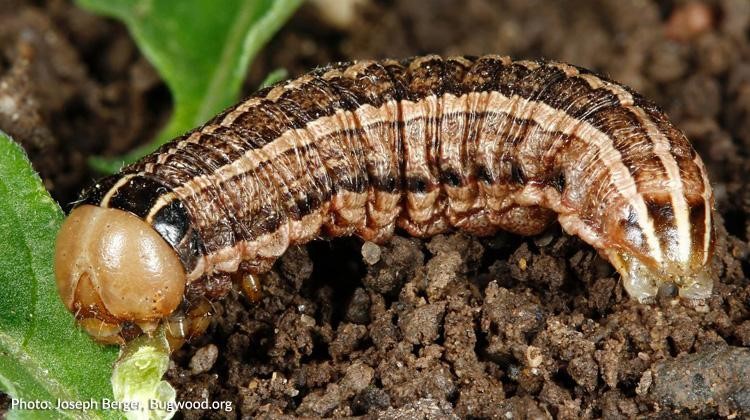
A type of larvae that feed on every part of the tomato plants. These types of caterpillars come in various patterns and colors like green, brown, gray, and yellow.
Other features and behavior:
- They grow to 1 to 2 inches.
- They curl up when you try to touch them.
- They can feed on tomato plants even on the surface of the soil
- They’re nocturnal and hide in the soil during the day and attack plants at night.
- During winter, they stay in the soil and farmers should take advantage of plowing the soil to control them.
How it damages tomato plants
It got its name as cutworm as it cuts through stems, stalks, and tomato fruits. Tomato seedlings take most of the damage as cutworms will feast on their growing stems and even kill them even before they develop fruits.
Then, they cut holes in the fruits of the mature tomato plants.
You might also like: Tomato Pesticides: Everything You Need To Know
2. Tomato Fruit Worms
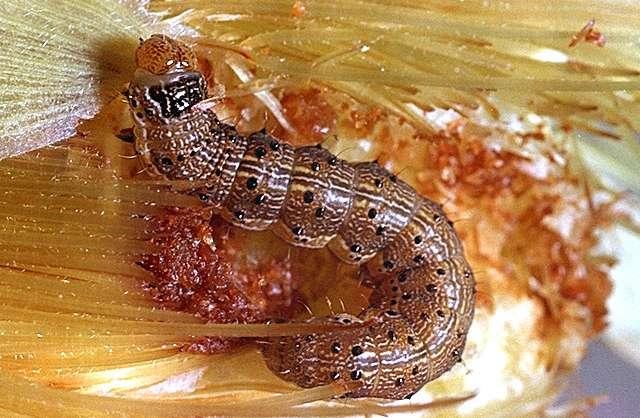
The caterpillars you often see inside the Tomatoes you buy in supermarkets. These are tiny caterpillars that grow inside the tomato fruits.
Other features and behavior:
- They become medium-sized moths when they grow.
- They start as a white caterpillar with black hair and a black head and turn into black or yellow-green as they mature. They have distinctive white stripes on their sides.
- Adult moths lay their eggs on the leaves at night.
- They love attacking green Tomato fruits and those that are about to ripe.
- When they’re done feeding on the Tomato plant, they stay on the ground and build a cocoon and stay there for 14 days before becoming a moth.
How it damages tomato plants
They enter the tomato fruits when they are still young and feed on the tomato fruit and grow inside it. Therefore, resulting in the damage of the fruit from the inside and liquifies the contents of the fruit.
3. Pinworms
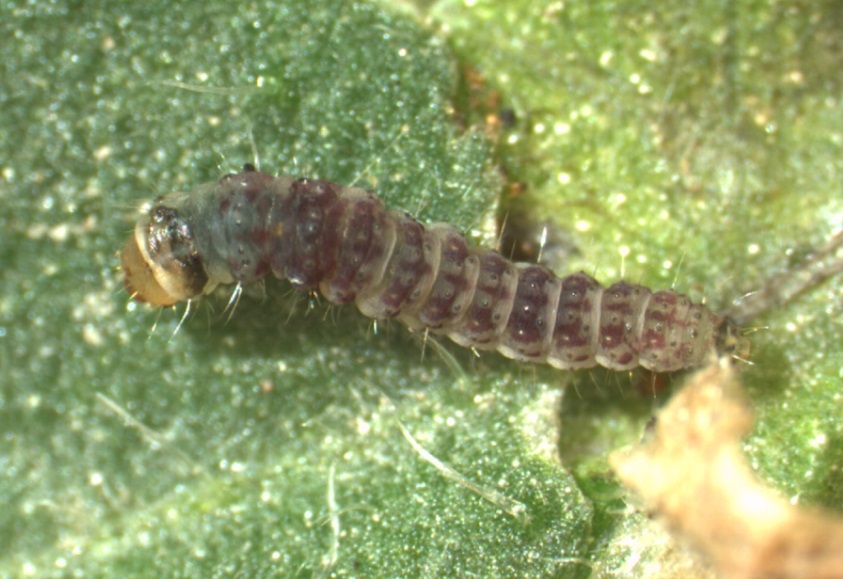
They are caterpillars that also feed on the leaves, stems, and fruits of tomato plants. They cause one of the biggest damages to tomatoes every season.
Other features and behavior:
- Young pinworms are usually light-colored and the adults turn into yellow, gray, red, or purple.
- They have silk that they use to build a tent and creates a passage to the leaves.
How it damages tomato plants
They feed on leaves and you can easily identify them when you see mines blotches on the leaves of your tomato plants like the damage done by leafminers.
4. Armyworms
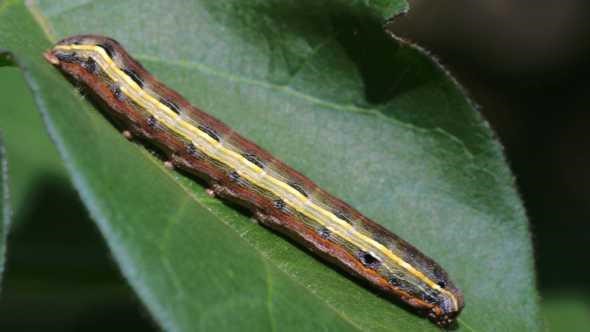
One of the common caterpillar infestations in tomatoes and are mostly referred to as the black worm.
They are dark-colored caterpillars that feed on almost all of the parts of the tomato plant from its leaves to its stems.
Other features and behavior:
- Armyworms got its name for being notorious for attacking crops in packs.
- Severe attacks of armyworms happen during the hottest season.
- They have a cannibalistic behavior where they eat their eggs if the food is scarce.
- A massive infestation has been recorded in Africa in 2016 where the infestation affected 28 countries in Africa.
How it damages tomato plants
Armyworms attack in packs and only feed on the surface of the fruit. However, it will feast on the stems and leaves of the tomato plants, contributing to its eventual death.
How To Get Rid of Black Worms In Tomato Plants
Now, with all the caterpillars mentioned above, you may have recognized the culprit of the damage in your tomato plants.
Now, here are some of the ways on how you can control the spread of these pests.
These includes:
1. Hand-picking The Pests and Their Eggs
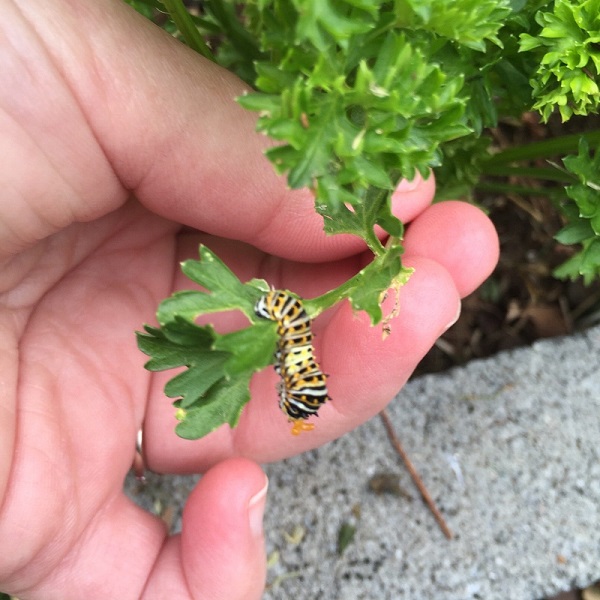
One of the effective ways of controlling pests that don’t need the help of any solution is picking them as soon as you see them.
If you’re lucky and you caught these black crawlers in the act of feeding on your tomato plants, use a glove, pick them up and pool them in a small container with dish soap solution to kill them.
The dish soap solution will help you kill the larvae and their eggs. You just need to mix one part of dish soap with 10 parts of water. The eggs of the larvae are microscopic and some may not be visible to the naked eye.
So, use a cloth and soak it with the dish soap solution to wipe the leaves gently. Focus on the nooks and crevices of the stems and the leaves to get rid of the eggs.
Keep doing this process if you still suspect any infestation. Otherwise, observe the plant for a day or two and see if there are still some lingering black worms around.
2. Propagating Helpful Predators
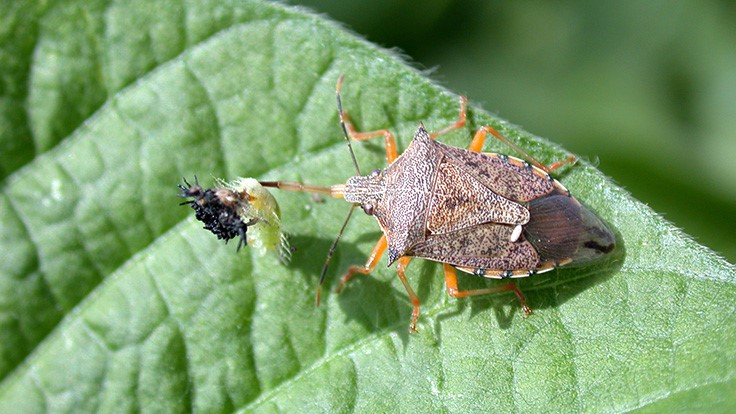
It is recommended by most garden experts that you should try natural pest control first before turning to pesticides.
The downside of using pesticides is that sometimes it also kills other beneficial insects around your garden like the pollinating ones.
So before you check out the best fertilizers for tomatoes in the market, you should try getting some help from the beneficial insects that will feast on the black worms on your plants.
Common natural predators of caterpillars include:
- Birds
- Lacewings
- Ladybugs
- Big-eyed bugs
- Minute pirate bugs
- Damsel bugs
- Parasitic Trichogroma wasp
- Braconid wasps
- Soldier beetles
- Spined Soldier Bug
- Tachinid Flies
3. Plowing Overwintering Pests in The Soil
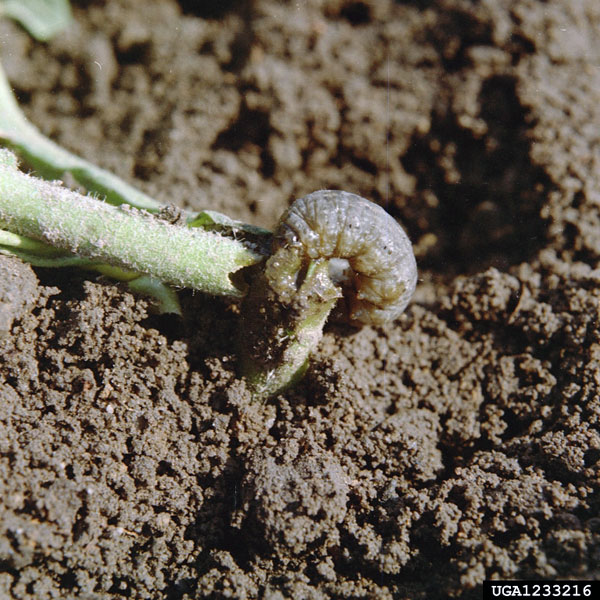
Both fruit worms and cutworms can hide in the soil during winter.
If you suspect that these are the worms that are feeding on your tomato plants, then use the winter and fall season to your advantage and plow the soil to expose them.
- First, after the growing season cleans the area from any debris, weeds, and dried leaves. Don’t use the dried leaves for compost as the caterpillars might still be hanging around.
- Till the land to help stir around the caterpillars on the soil. Disturbing the compact soil also helps keep the air circulation and remove clumps in preparation for the next spring season.
- Let your chickens or birds feast on the surfacing larvae in the soil. Not only does it save you from feeds but also helped you control the pests.
4. Homemade Pesticides

Did you know that several items in our kitchen can be the solution to your pest problems?
Many organic gardeners swear by some of the homemade pesticides that they use at home that save them from using commercial insecticides.
Here are some of the pest control solutions that you can use for your tomato plants:
- Tobacco juice: If you have someone in your family who smokes cigarettes, collect their old cigarette butts and leftovers to put them to good use. Soak all the cigarette butts and leftovers in water and let them sit for a couple of days. Then. filter the solution with a strainer or a stocking and pour it around your tomato plants.
- Garlic solution: Crush 2 bulbs of garlic and mix it with water and let it sit for 12 hours. Then, add 1/2 cup. of vegetable oil, ground peppers, and 1 teaspoon of mild soap.
- Vinegar solution: Vinegar is not only useful as an ingredient and cleaning agent but also as a natural insecticide. Its acidic nature helps repel insects and other pests in your tomato plants. Mix two tablespoons of vinegar in four liters of water.
5. Commercial Pesticides
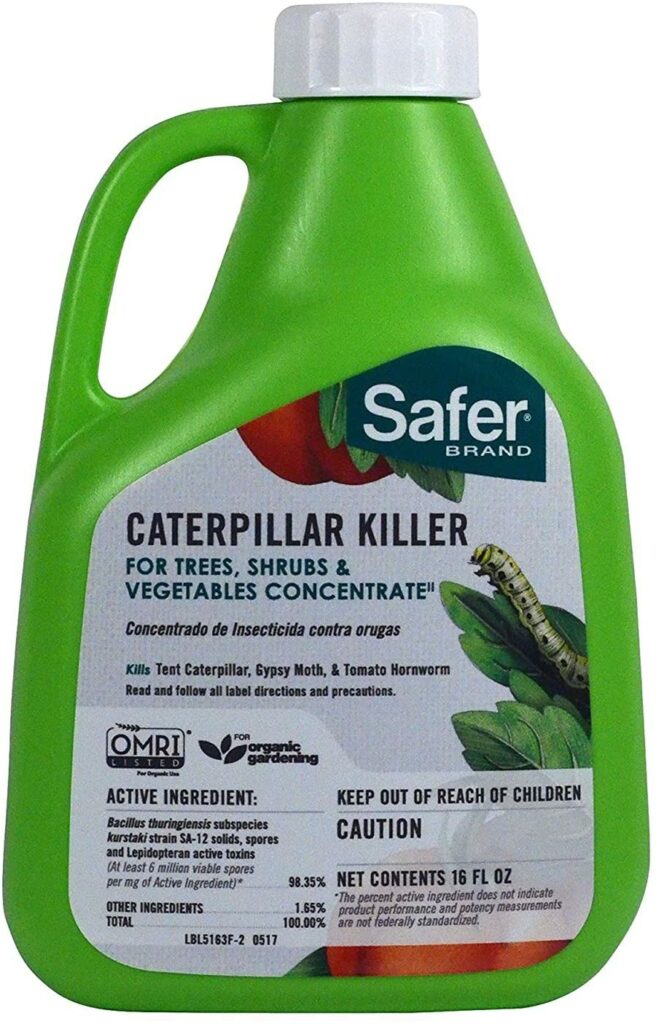
Of course, if you’re already experiencing heavy infestation on your tomato plants, pesticides might do the trick.
You have several options in the market for getting rid of caterpillars. However, there are specific formulas that have been the holy grail of gardeners when it comes to unwanted crawlers.
These includes:
Bacillus Thuringiensis (Bt)
A biological type of insecticide that contains bacteria in the soil that produces toxic proteins to caterpillars.
This insecticide works by attacking the digestive system of the caterpillars when they consume it.
Its contents are naturally occurring in the soil so you can use it on your tomatoes until the day of harvest. It remains active for 24-48 hours upon application and works best on young larvae.
Here are some of the best Bt brands in the market:
Neem oil
A multi-use organic insecticide that has been used for years in taking care of crops. It works as an insecticide, fungicide, and miticide. It’s natural so you can spray it on your tomato fruits until you harvest them.
The only downside with this oil is it has a bit of a smell.
Here are some of the best brands of neem oil in the market:
Spinosad
Another biological insecticide that contains a different kind of soil bacterium. It’s popular for killing thrips and caterpillars in tomatoes. The pests must ingest the bacterium for it to work on them.
Here are the best spinosad fertilizers in the market:
Tips in Keeping Blackworms Away From Your Tomato Plants
Now that you’ve been equipped with the solutions to address the caterpillar infestation in your tomato plants, it will be easier for you to control the black worms.
However, here are some helpful tips for successful pest control:
- Try physically removing the pests before considering pesticides. Pesticides may have a tendency to kill the beneficial insects that play a great role in the ecosystem of your garden. Consider synthetic insecticides as your last option.
- Always use protective gear in handling insecticides regardless if they’re organic or not.
- Always check the labels for proper application and to avoid burning your plants.
Final Thoughts
Caterpillars are sneaky and may not show up during the day. So it would take careful observation to catch them in the act of feeding on your plants.
We hope that this article has helped you have an idea on how to win your tomato plants over the black worms.
If you find this post helpful and informative, please don’t hesitate to share it with your friends.
What pest control worked for you? Let us know in the comments below!
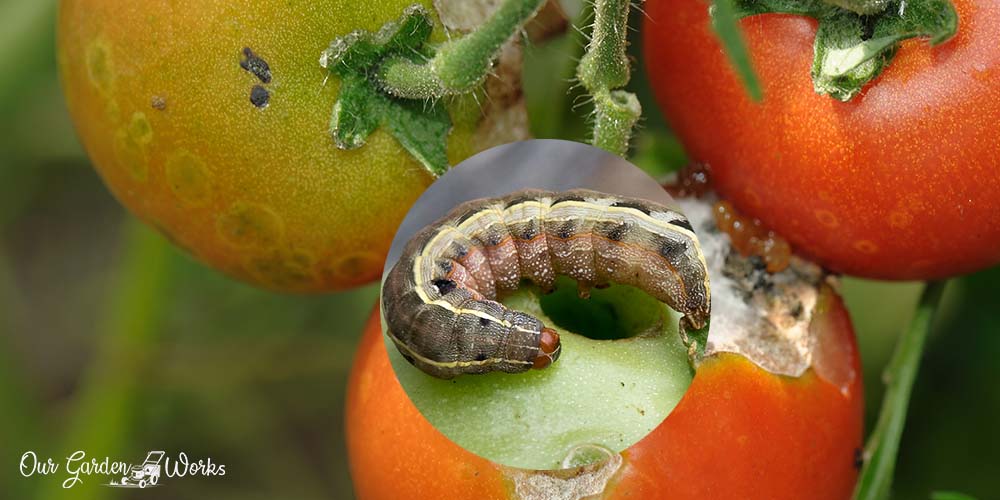
Super helpful! I’ll try your non-pesticide treatments first. The picture of the black and yellow caterpillar in your parsley is a swallowtail butterfly. I plant parsley and dill just for them! I’ve never seen them in my tomatoes.
Thank you, Lexi,
Hope this helps!